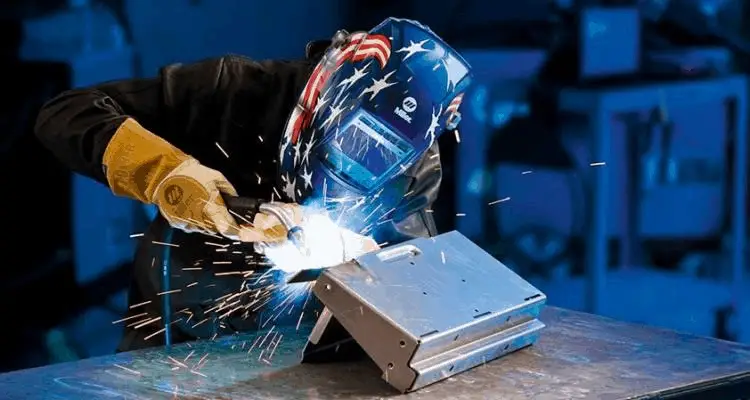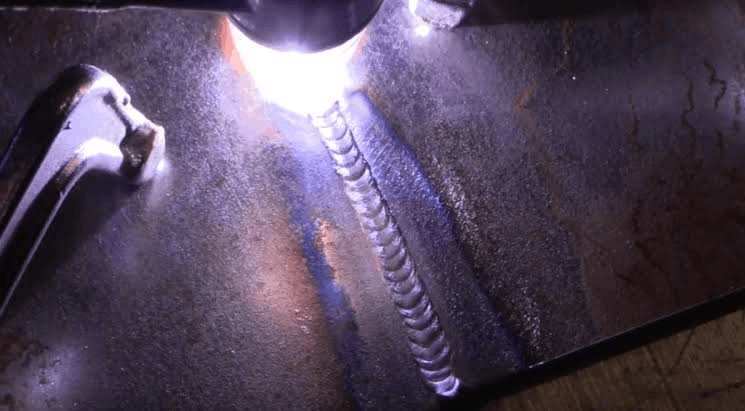It is impossible to do welding without experiencing some form of warping of sheets. Even the most experienced of welders experience weld distortions/warping. When metal is heated it expands and contracts in all directions. These stress in metal causes warping. Instead of trying to avoid warping all together, the best cause of action would be to prevent it.
What specifically causes warping is when a metal is heated during welding the temperatures are not unrestrained meaning the metal receives varying temperature ranges. During cooling this plays out and you have warping.
How warping occurs in a metal
During MIG or TIG welding you have the base metals been joined by some filler metal. Welding occurs at temperatures above 2,500˚F (1,370C). The heat from the welder spreads out causing your metals to expand. However, as the beads solidify during cooling, they do not in the same way as the metals are now fused. The contraction is not uniform which leads to twisting and warping. Some metals like copper and aluminum have lower cases of warping as the heat in the metals spreads out. The contraction and expansion occurs over a larger area. Stainless steel one of the most used metals has higher incidences of warping due to its higher coefficient of expansion and low conductivity.
Weld warping corrective techniques
The primary way of eliminating warping is through hammering. Here you apply force on the warps in an effort to flatten the out of place surfaces. This however, is tiring and burdensome and you need some energy for it to work. You can use a heavy hammer for this or pneumatic ram, wedge or machine press. In the alternative there are various thermal corrective techniques that you can deploy including spot heating, line heating, and wedge heating.
Spot heating
Thermal correction of metal warping is premised on the idea of creating local stress that is high enough to pull back the metal warped back to shape during cooling. Spot heating is ideal for removing warping in your thin metal sheets. In the process, heat is applied to certain spots on the convex side of the warped metals. If you want to succeed ensure you make smaller spots as opposed to larger ones.
Line heating
This is used to remove angular distortions. It works by heating the welded joint along a straight line on the opposite side of the weld.
Wedge-shaped heating
This is for larger complex fabrications and involves heating the wedge shapes.
How to fix warped sheet metal after welding

Since you cannot completely eliminate weld warping the best course of action is in prevention. You can control the heating and cooling hence reducing the chances of getting warps.
Avoid over welding your metals
It is tempting to over weld your metals with the aim of making them stronger but this only increases your chances of getting more distortions. The rule is the more metal you place on a joint the more the weld warping. If you want to save time and money properly correctly size your weld to the joint before welding. If you want to reduce the weld metal in the fillet weld then using a slightly convex or flat bead. This is because the excess metal in a highly convex bead does not give your work more strength but works in the reverse to increase distortions. Planning on doing some thick plate welding then go for beveling or double beveling.
Clamping
Position clamps in the weld so that hold the weld until you finish welding. Removing the clamps does not reduce distortions but it helps in case of movement during welding.
Penning
This is the term used for hammering a product. The aim is to stretch the weld hence reducing stress and distortions. Be careful during penning because when used during the final pass it can accidentally cover a crack hence reduce the structural strength of the metal.
Intermittent welding
Instead of using continuous welds try intermittent ones. When you are attaching stiffeners it has been seen that the intermittent welding can reduce weld metal and strength.
Fewer weld passes
Instead of going for large weld passes use smaller ones. It has been proven that weld shrinkages accumulate with each passing weld pass. The less weld passes you have the less distortions you experience.
Placing welds near neutral axis
Doing this gives your shrinkage forces some room to pull the misaligned plates. You can also balance the welds along the neutral axis for warping control.
Backstep welding

In this technique you weld left to right while depositing the bead segment in the reverse – right to left. Once you have placed the bead segment the edges get heated and this temporarily separates the plates. The expansion caused by the heat moving out causes the plates to come back together. It minimizes distortions by allowing successive beads to expand less due to the restraint they receiving from prior weld cause.
Alternate welding sequence
In this technique you try to sequence your welding. During the assembly shrinkages will originate from one part of the weld but they are counteracted by opposing shrinkage from another part. This helps in reducing weld warping.
Water-cooled jag
A water-cooled jag helps in heat dissipation from the welded components by circulating water through the weld using tubes. When combined with clamps it is a sure way to minimize distortions.
Strongback
You can use this tool for controlling distortions in butt-welding. In the process, one will weld clips on the edges of the plates. Wedges are then run under the clips and this forces the alignment of the edges hence preventing distortions.
Factors that affect welding distortions
Parent material properties
These influence distortions through the coefficient of thermal expansion as measured by the heat per unit volume. The root cause for metal distortions is expansion and contraction of the metal. The heating of the metal causes non-uniform stresses. You have the base metal been combined with filler metal. It is during cooling that the metal warps as it tries to go back to its original shape. In this regards, the basic material composition of your metal will determine the extent of the warping. It is known that stainless steel coefficient of expansion is greater than carbon steel this results in greater distortions.
Joint design
When it comes to the joint design know that there particular joints that are prone to warping than the rest. This includes butt and fillet joints. You can minimize the distortions by adopting or replacing them with a joint type that well balances the thermal stresses by adjusting the plate thickness. Instead of going with the single sided weld go for the double sided one, this helps in eliminating angular distortions.
If you want consistent shrinkages then go for uniform fit ups that produce predictable weld warps. If you are having large joint gaps then know that this will only be filled by weld material. Make an effort to tack the joints so that you have little relative movement between the parts during welding.
Weld allowance to avoid distortions
This will largely depend on the type of distortion. During cooling you can either have a longitudinal shrinkage or transverse one. Angular distortions are caused by non-uniform contraction during cooling. If you are doing a single butt weld you should note that the first weld run will produce transverse and longitudinal shrinkages and rotation. The second run will cause your plates to rotate resulting in the first weld acting as a fulcrum. This balanced welding helps prevent angular distortions and produce uniform contraction in a double sided V butt joint.
To curb the angular distortions make a filled weld allowance of 0.8mm per weld. In this case the leg length should not exceed a plate thickness of ¾ inches.
If you have a single side fillet weld then expect the angular distortions of the upstanding leg as you have non-uniform contractions. While the double side fillet welds are great at controlling distortions in the upstanding fillet you will still have angular distortions in the plate as the weld is only deposited on one side of the plate.
If you are experiencing longitudinal bowing it is because the welded center is not coincident with the neutral axis. This causes the longitudinal shrinkages bend the curved section. To solve this have clad plates that have a tendency to bow in two directions. Angular distortions also cause the plates dishing inwards in between stiffeners.
For longitudinal shrinkage have a fillet weld allowance of 0.8mm weld of 3m and for butt welds 3mm per weld of 3m. Note that if you increase the leg length of the fillet welds then you increase your chances of shrinkages.
Conclusion
Warping of metal sheets is something all welders experience both novices and professionals. While there are methods of removing the warping like hammering and thermal techniques, the best cause of action is to prevent warping before it occurs. This means you should make every effort not to over weld you pieces while keeping a keen eye on how you place your welds.
